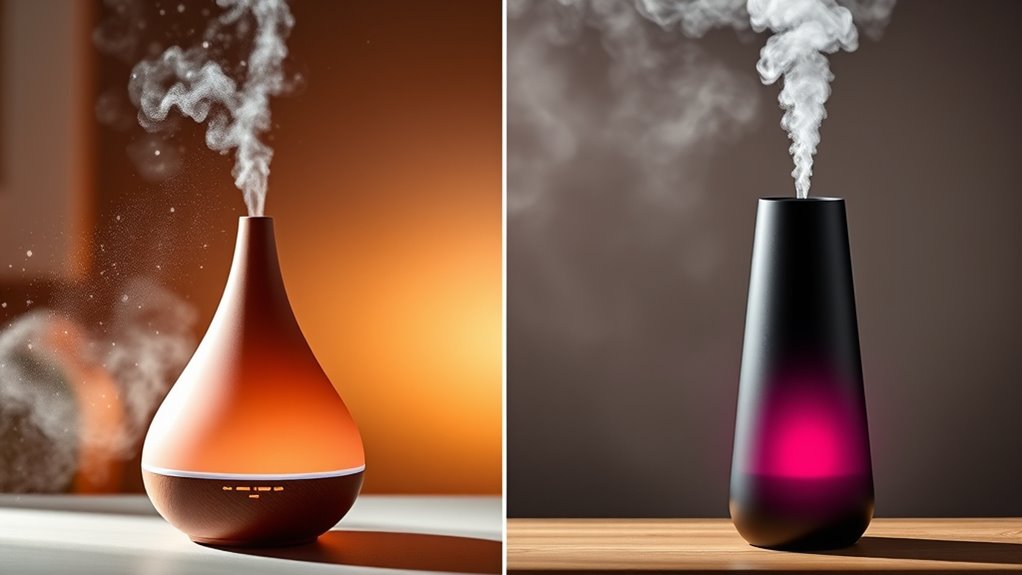Ultrasonic and nebulizing essential oil diffusers serve different purposes. Ultrasonic diffusers mix water and oil, producing a quiet mist ideal for bedrooms and offices, while nebulizing diffusers release pure essential oils without water, offering a more concentrated aroma but can be noisier. If you’re after budget-friendliness and humidification, go for ultrasonic. If potency’s your priority, consider nebulizing. Each type has its unique benefits, so you’ll want to explore what fits your needs best.
Key Takeaways
- Ultrasonic diffusers mix essential oils with water, using vibrations to create a quiet mist, while nebulizing diffusers atomize pure oils directly without water.
- Ultrasonic diffusers are quieter (20 to 40 dB) and consume less oil, making them budget-friendly for everyday use.
- Nebulizing diffusers provide a concentrated aroma by releasing pure essential oils, ideal for addressing acute health issues.
- Both diffuser types preserve therapeutic benefits by avoiding heat; however, nebulizing diffusers offer a richer, more potent essential oil experience.
- Regular maintenance is crucial for both types to prevent mold and ensure optimal performance and therapeutic quality.
Overview of Essential Oil Diffusers
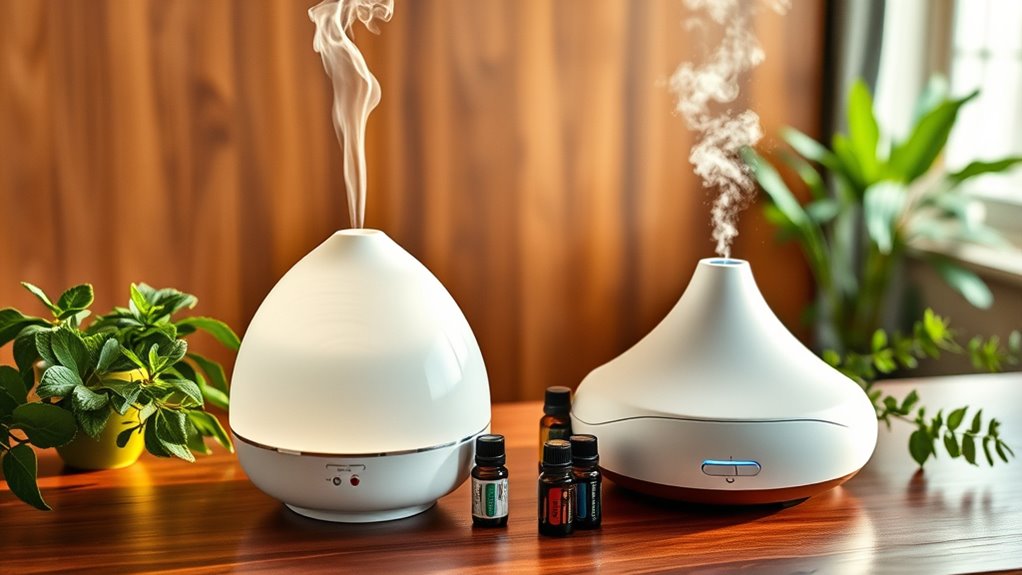
Essential oil diffusers are popular devices that enhance your environment by dispersing fragrant oils into the air.
You can choose between two main types: ultrasonic diffusers and nebulizing diffusers.
Ultrasonic diffusers combine water and ultrasonic vibrations to create a fine mist, making them quieter and budget-friendly. Additionally, they can improve indoor air quality by dispersing essential oils that have natural antibacterial properties. Using essential oils for respiratory health in these diffusers can further support a healthier environment. Moreover, many essential oils, such as lavender and eucalyptus, are known for their mood-enhancing effects. These diffusers are also favored for their ease of use and versatility in various settings.
Ultrasonic diffusers use water and vibrations to produce a quiet, budget-friendly mist for your space.
In contrast, nebulizing diffusers atomize essential oils directly, producing a concentrated mist that preserves the oils’ therapeutic properties.
The choice between these two often comes down to personal preferences and how you intend to use them.
If you’re looking for the benefits of aromatherapy, consider how concentrated you want the mist to be. Regular use of essential oils for relaxation can enhance your overall well-being and create a calming atmosphere.
How Ultrasonic Diffusers Work
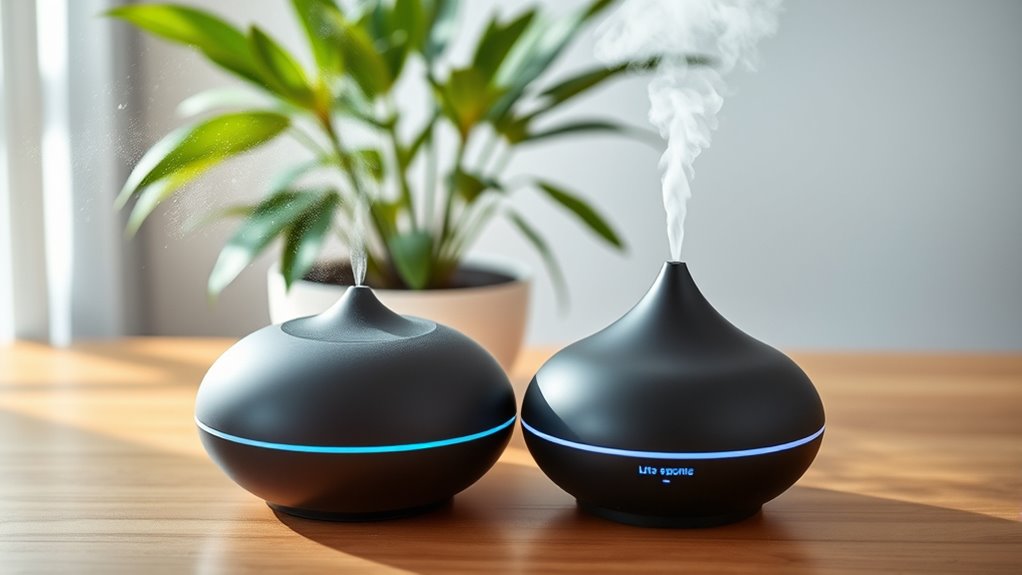
Ultrasonic diffusers utilize a simple yet effective mechanism to disperse essential oils into the air. These devices use a built-in water tank to mix essential oils with water, creating a fine mist through ultrasonic vibrations.
A small disk inside generates ultrasonic waves, breaking down the mixture without altering the therapeutic properties of the oils, thanks to the absence of heat. Typically, you only need 5 to 10 drops of essential oil mixed with water for effective operation, making ultrasonic diffusers economical for daily use. Additionally, freshly squeezed juices can be a great complement to the calming atmosphere created by these diffusers. Furthermore, the mist produced can help increase local humidity levels, which is especially beneficial in dry environments. Studies have shown that antioxidants present in essential oils can contribute to overall wellness, enhancing the relaxing effects of the diffuser. With a quiet operation, usually between 20 to 40 dB, these diffusers are perfect for bedrooms and offices. Furthermore, the incorporation of wellness in daily life can be enhanced by using ultrasonic diffusers to create a calming atmosphere. Moreover, the use of essential oils in these diffusers reflects a long-standing tradition of utilizing natural substances for cultural significance, emphasizing their role in enhancing well-being and ambiance. Additionally, the soothing effects of these diffusers can be complemented by drinking juices rich in vitamins A, C, and E, which promote skin health and enhance overall wellness.
How Nebulizing Diffusers Work
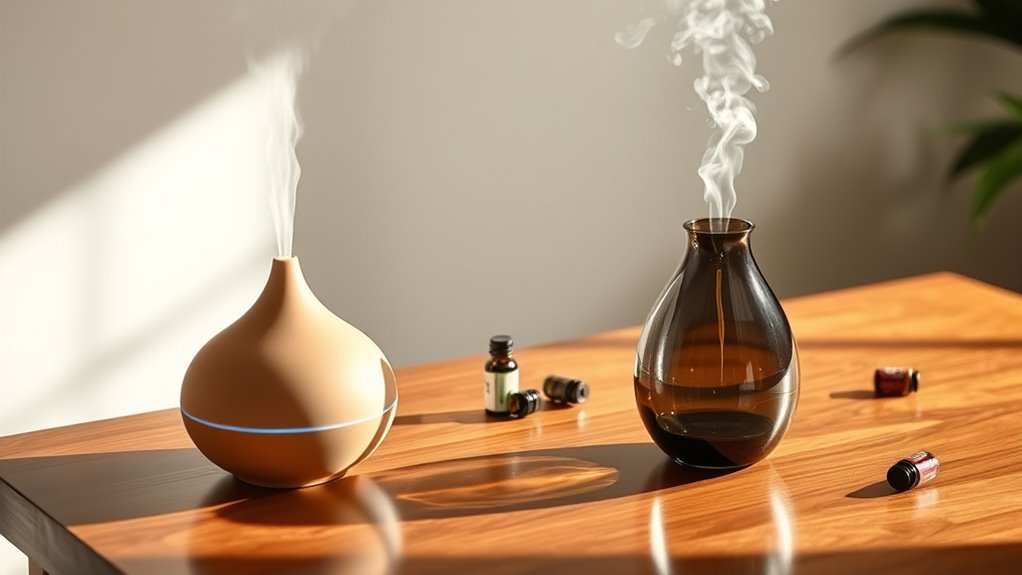
Nebulizing diffusers offer a different approach to dispersing essential oils by using high-velocity, pressurized air to create an ultra-fine mist. This process, based on the Bernoulli principle, breaks the essential oil into micro-particles without the need for water or heat, preserving the oils’ chemical composition. Unlike other diffusers, nebulizing diffusers release the entire essential oil at once, providing a more concentrated aroma that’s ideal for therapeutic applications. You’ll notice that these diffusers typically consume about 10 drops of essential oil in less than an hour, making them efficient for maximizing scent. Additionally, using a nebulizing diffuser can contribute to improved overall well-being by enhancing air quality, similar to the benefits provided by air purifiers. HEPA filters in air purifiers are effective at removing pollutants, which can further enhance the overall environment when using essential oils. Regular cleaning of nebulizing diffusers, similar to air purifier maintenance, is essential for ensuring optimal performance and preventing any buildup that could affect its functionality. Choosing the right diffuser can significantly impact your experience, as proper maintenance ensures optimal performance and extends the lifespan of the device.
Key Differences Between Ultrasonic and Nebulizing Diffusers
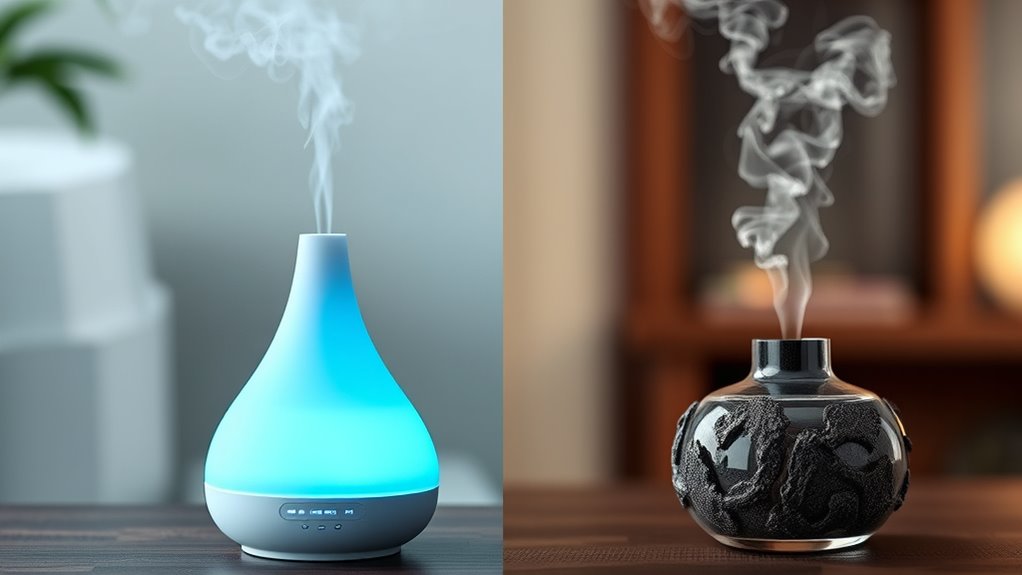
When choosing between ultrasonic and nebulizing diffusers, it’s important to understand how each operates and their therapeutic benefits. Ultrasonic diffusers mix water with essential oils, while nebulizing diffusers atomize pure oils for a more concentrated aroma. Additionally, essential oil safety is crucial when using any diffuser, as improper use can lead to adverse effects. Regular use of essential oils can also promote skin hydration and overall wellness when integrated into your beauty routine. Understanding the emotional states reflected in your aura can further enhance your experience with essential oils, as they can influence your overall well-being. Both types of diffusers can help create an environment filled with spiritual principles that encourage relaxation and mindfulness, as utilizing spiritual energy can enhance the effectiveness of these aromatic practices.
Operational Mechanism Differences
Ultrasonic diffusers use a built-in water tank and ultrasonic vibrations to create a mist, breaking essential oils into microscopic particles combined with water. This method relies on evaporated water particles to carry oils into the air, which can dilute the potency of the essential oils. In contrast, airless paint sprayers are designed to provide a smooth finish with minimal effort, showcasing the efficiency of modern technology in various applications. Additionally, the use of air quality is crucial for maintaining optimal performance in any system. The transformative possibilities of imagination can inspire users to explore creative ways to enhance their aromatherapy experience.
On the other hand, nebulizing diffusers operate using an air-jet pump to atomize pure essential oils without water or heat. This allows them to disperse the entire essential oil at once, preserving its chemical composition and enhancing its therapeutic benefits. Consequently, while both types avoid heat, nebulizing diffusers offer a more concentrated delivery of essential oils. Additionally, the high refresh rates of nebulizing diffusers can lead to a more immediate and intense aromatic experience. By understanding the mental wellbeing index, users can better appreciate the emotional and psychological benefits that essential oils can provide.
Therapeutic Benefits Comparison
While both ultrasonic and nebulizing diffusers serve the purpose of enhancing your environment with essential oils, their therapeutic benefits differ markedly.
Nebulizing diffusers provide a concentrated and pure essential oil experience, preserving the full therapeutic benefits without the dilution of water. This concentrated mist makes them perfect for addressing acute health issues and maximizing the impact of oils in aromatherapy.
In contrast, ultrasonic diffusers mix essential oils with water, which can compromise the intensity of their therapeutic effects, though they’re more budget-friendly for daily use due to lower oil consumption.
Remember that regular maintenance is vital for both types; neglecting water changes in ultrasonic diffusers could lead to mold, impacting the therapeutic quality of your oils.
Therapeutic Benefits of Each Diffuser Type
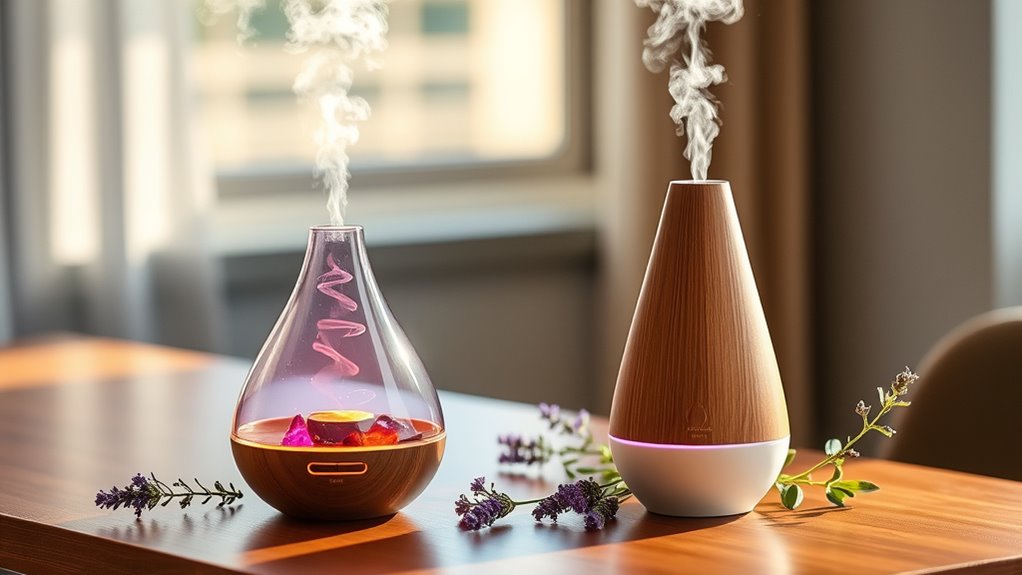
Understanding the therapeutic benefits of different diffuser types can greatly enhance your aromatherapy experience.
Nebulizing diffusers deliver a concentrated mist of essential oils without heat or water, preserving their therapeutic properties. This potent vapor is particularly effective for acute ailments, maximizing health benefits.
Nebulizing diffusers provide a concentrated essential oil mist, preserving their therapeutic benefits for acute ailments.
On the other hand, while Ultrasonic Essential Oil Diffusers dilute oils with water, they can help humidify the air, offering respiratory advantages in dry environments. However, this dilution may lessen the direct therapeutic impact of the essential oils.
Both diffuser types promote stress relief, improved sleep, and immune support, but if you’re after a richer, more potent essential oil experience, nebulizing diffusers are your best bet for superior therapeutic efficacy.
Maintenance and Care for Diffusers
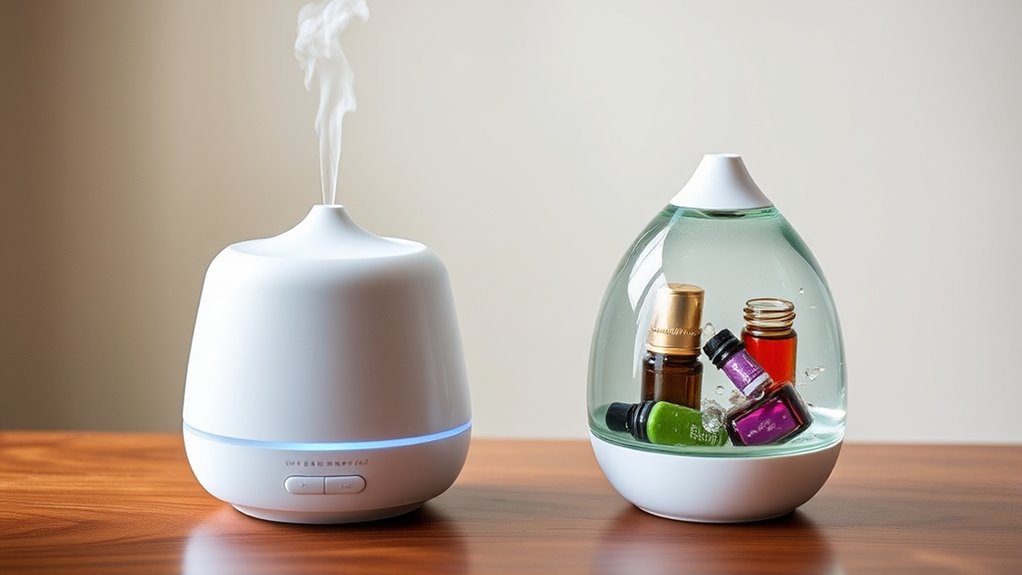
To keep your essential oil diffusers functioning at their best, regular maintenance is crucial.
For ultrasonic diffusers, make certain to empty, rinse, and dry the unit after each use. This prevents mold and bacteria growth from residual water.
Nebulizing diffusers require thorough cleaning of the essential oil reservoirs to avoid oil buildup and maintain the purity of future diffusions. Use natural cleaners or isopropyl alcohol for effective sanitation.
Always check the compatibility of your essential oils to avoid damaging components.
For peak performance and longevity, follow the manufacturer’s recommended maintenance schedule, which includes detailed cleaning instructions and inspections.
Essential Oil Selection for Diffusers

When choosing essential oils for your diffuser, consider their compatibility with the device type and the desired therapeutic effects.
You’ll want to prioritize high-quality oils to guarantee purity and maximize aroma profiles.
Also, be mindful of the strength of the oils to prevent any negative interactions with your diffuser.
Oil Compatibility Considerations
Choosing the right essential oils for your diffuser is crucial for maximizing their benefits and ensuring compatibility with your device.
When using ultrasonic diffusers, you’ll need to mix a few drops of high-quality essential oils with water, but be careful with strong oils, as they can corrode plastic components.
On the other hand, nebulizing diffusers use pure essential oils without any dilution, preserving their therapeutic benefits and providing a more concentrated aroma.
It’s important to evaluate oil compatibility when selecting oils for your diffuser type. Some oils may not perform well in ultrasonic diffusers due to the presence of oil and water, while nebulizing diffusers can handle more potent oils without compromising their integrity.
Quality and Purity Importance
Ensuring you select high-quality essential oils is vital for getting the most out of your diffuser. The quality and purity of these oils directly impact their therapeutic benefits. Nebulizing diffusers preserve the integrity of essential oils since they don’t use water or heat, while ultrasonic diffusers may dilute oils, compromising their effects. To maximize aromatherapy, opt for 100% pure oils from reputable brands like doTERRA or Rocky Mountain Oils.
| Type of Diffuser | Key Feature | Recommended Oil Quality |
|---|---|---|
| Nebulizing Diffuser | No water or heat | 100% pure, high-quality |
| Ultrasonic Diffuser | Uses water, may dilute oils | 100% pure, high-quality |
| Essential Oil Source | Reputable brands | Natural and therapeutic |
Strength and Aroma Profiles
The strength and aroma profiles of essential oils play an essential role in your diffuser experience.
If you’re using ultrasonic diffusers, you’ll notice a diluted aroma due to the water mixed with just a few drops of essential oil. This can compromise the therapeutic benefits you seek.
On the other hand, nebulizing diffusers deliver a concentrated aroma and preserve the integrity of essential oils, making them ideal for strong oils like eucalyptus or peppermint.
These diffusers provide a richer scent quality in a shorter time, ensuring you enjoy the full potency of your oils.
Choosing the right diffuser for your essential oils is important to maximize both aroma and therapeutic benefits.
Choosing the Right Diffuser for Your Needs
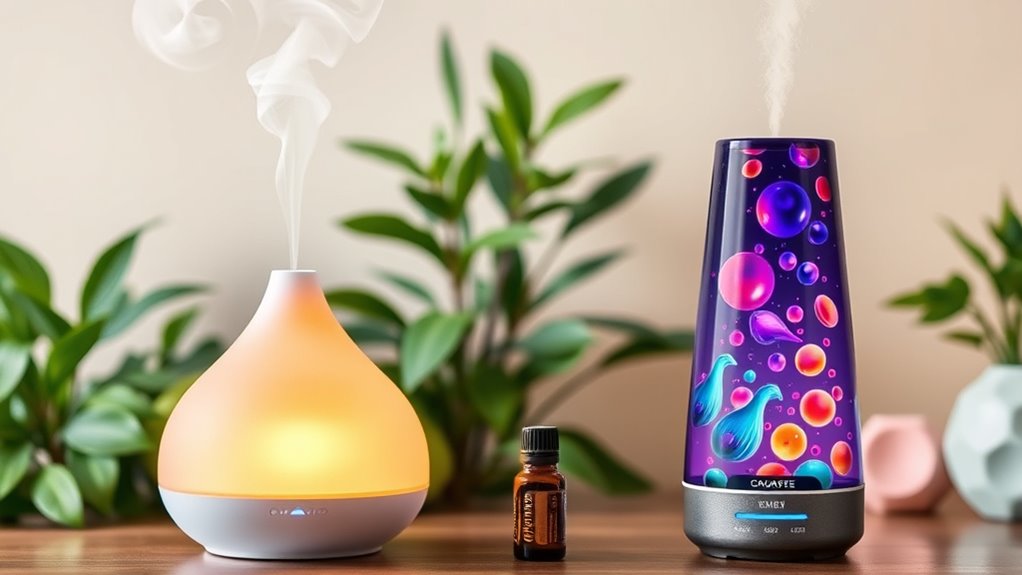
How do you find the right diffuser to suit your lifestyle and needs?
If you’re after an affordable option for everyday use, ultrasonic diffusers are a great choice. They’re budget-friendly and can double as humidifiers, using less essential oil while still providing therapeutic benefits.
However, if you want a more intense aromatic experience, consider a nebulizing diffuser. These devices deliver a concentrated mist of essential oils without water, ensuring you get the full strength and purity of the scents.
For a powerful aromatic experience, opt for a nebulizing diffuser that releases pure essential oil mists without water.
Keep in mind that nebulizing diffusers consume oils faster and may be noisier.
Think about your environment, humidity levels, and desired effects to help you choose the right diffuser for your needs.
Frequently Asked Questions
What Is the Most Effective Type of Diffuser?
When you’re choosing the most effective type of diffuser, it really depends on your specific needs.
If you want a strong, concentrated aroma with maximum therapeutic benefits, you might prefer a nebulizing diffuser.
However, if you’re looking for something more economical and versatile for everyday use, an ultrasonic diffuser could be the way to go.
Consider how much oil you want to use, the aroma strength, and your personal preferences to make the best choice.
What Are the Cons of Ultrasonic Diffusers?
While ultrasonic diffusers are popular, they come with some downsides you should consider.
They dilute essential oils with water, which can lessen their effectiveness. You also need to clean them regularly to avoid mold growth and maintain performance.
Additionally, they may not deliver the strong aroma some people prefer, and the plastic parts can corrode over time, affecting oil quality.
Plus, you might find them noisy in quiet spaces.
Are Nebulizing Diffusers Worth It?
If you’re considering a nebulizing diffuser, it can definitely be worth it, especially if you prioritize the therapeutic benefits of essential oils.
They deliver a potent and concentrated mist without water, maintaining the oils’ integrity. However, keep in mind that they consume oil quickly and usually come with a higher price tag.
If you’re invested in enhancing your aromatherapy experience and don’t mind the cost, a nebulizing diffuser could be a great choice for you.
What Is the Healthiest Way to Diffuse Essential Oils?
Imagine you’re a gardener, nurturing the purest flowers. To keep their essence intact, you’d avoid mixing them with water, right?
The healthiest way to diffuse essential oils is to use a nebulizing diffuser. It releases a concentrated mist, preserving the oils’ therapeutic properties without dilution.
This method guarantees you breathe in the full potency, just like savoring a flower’s fragrance in its truest form. You’ll feel the benefits stronger and quicker, enhancing your well-being.
Conclusion
To sum up, understanding the differences between ultrasonic and nebulizing essential oil diffusers can help you choose the right one for your needs. Did you know that nearly 60% of essential oil users prefer ultrasonic diffusers for their quieter operation and added humidifying benefits? Whether you’re after a more intense aroma or a soothing mist, both types offer unique advantages. So, pick the diffuser that aligns with your preferences and enjoy the therapeutic benefits of essential oils in your space!
